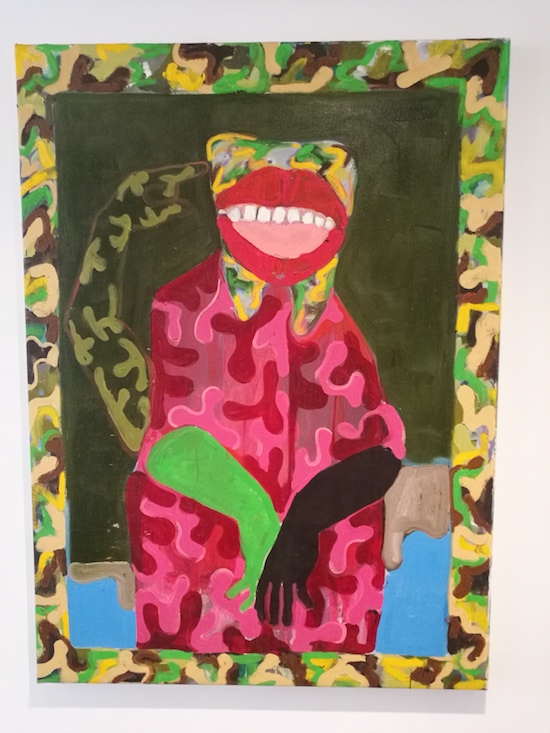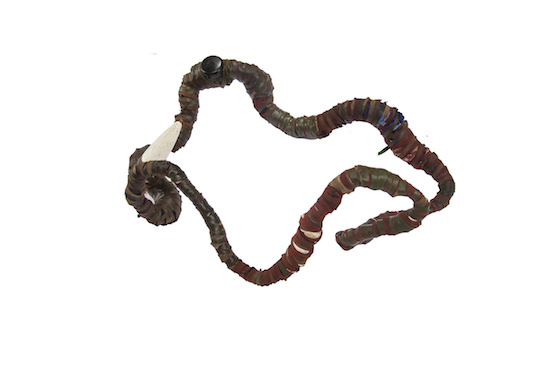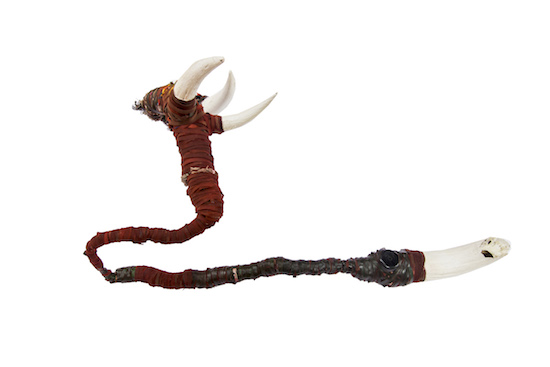Kubatana, Kristin Hjellegjerde tells me, can be loosely translated from chiShona as “togetherness”. There’s community and relationship buried in the paint and twisted cloth. There’s grandmothers and possibly your father on the black telephones woven into the woven wire sculptures. Is that you? Can you hear me?
They have been silenced. Mouths scream silently through the white teeth between the great worm-soft lips loosely drawn in bright paint round the room. The animal twists of echo back, the horns of Africa looking at you down the tusky points.
I’ve just walked in off Old York Road, two seconds from Wandsworth Town station into an exhibition of two young artists, fresh from Mbare in Zimbabwe. Fresh from post-Mugabe era. Two artists, doing their own work. I’m connecting them to each other. I’m thinking about what I know of Zimbabwe, a country I’ve never been to but have seen many times on Reuters news stories as an archivist, witnessing those huge parades from the distance of my Grays Inn Road basement, flashing before me on raw video. It’s jumbling in my mind and it’s making some kind of sense. Community. Parents. Parents’ parents. The theatre of the state. The good time feeling, the release of turmoil, the expression of inner anxiety.
It’s all splashing out now on the walls of this high street which may be uber-gentrified old London but which is fighting off the supermarket chains with a hipster mentality. Zimbabwe’s breaking-out, thoughts from Harare peeling towards me in the paintings of Gresham Tapiwa Nyaude, bright and psychedelic, reminding me of my own love-affair with late 1960s art with its flowing lines, its comedy and commentary, pushing the boundaries, shouting in colour. And the organic past is sinewing its way towards me in the wood-like, curving shapes of the long snaking sculpture of Takunda Regis Billiat.
Kristin tells me fascinating stories of curating the show, describes with a thoughtful emotion the kindness of the artists to her. She opens up hidden meanings to me, interesting background that I would never know without her insight. Take the vivid camouflage patterns in Gresham’s paintings. They are, apparently, because it is, or was, forbidden to wear camouflage in Zimbabwe. That has something to do with this choice, I try to unpick this as my eyes follow the patterns. The tension here is bizarre, absurd and this knowledge adds to my appreciation of the painting’s vigour.
Bringing Takunda’s sculptures here has had some odd, unexpected struggles over the materiality of the work. The cow horns were an issue for customs. Paperwork had to be produced to prove the cows had died of natural causes. It’s good that there’s checks on animal products – I don’t want animals murdered for art and shipped from Africa to London – but what a headache for the curators. But it’s exciting too. Kristin rides it like a mighty matriach, thriving on the challenges. As we talk she gets more requests in to buy pieces from the exhibition and she tries to work out her visa to Senegal.

I was hoping that my friend Pax Nindi from Harare Dread could have been with me to go round the exhibition and give me his thoughts as a fellow artist from Mbare but one who had to leave to pursue his life as an international musician. I would have been happy to have his opinions and ideas to save me from mindlessly repeating phrases from the gallery text such as Gresham’s “images oscillate between abstraction and hallucination, drawing from the restless energy of the ghetto”. I feel uncomfortable with the word “ghetto” and I struggle with how to describe this process of how experience has transcended poverty into incredible vibrancy.
But I do like the word “hallucination”, it feels right for Gresham’s dream-heavy paintings where faces lack eyes and noses, faces remind me of frogs and legs seem to come from everywhere. Perception is distorted, not by being high or by being stoned but I am seduced into responding to the world in a different way. These pictures are mind drugs and this is a revolution.
Takunda’s sculptures create a calmer space, winding history around the lines in ribbons. Messages from the blood. Asemic writing. I note the symmetry of the art on the wall but until Kristin tells me I don’t realise that this is a word being spelled out here. It’s playful. It’s witty. I won’t say what it says as this is the thrill of visiting in person – that there are things to discover.
And people are visiting Kristin Hjellegjerde’s gallery from different groups in the community. While we talk, she takes a booking for fifty schoolchildren to see Kubatana. “Oh yes,” she says on the phone, “we’ve had fifty in here before.” The space is not huge but it’s okay. They can pack in and still appreciate it.
It’s my second visit to the space and I really admire the hanging, the shape the use of extra walls that seem part-pillar, part-wall to show off the work.

What Kristin is doing as a modern gallerist is incredible. She’s full of light and energy and so is this space. She’s focusing on narrative work, work with something to say internationally. As well as fun, her gallery is hugely ambitious in terms of scale and presence. I never feel on the spot as I take my time to ponder the art and chew over what it says to me. I don’t feel as though I’ve entered a panopticon-style prison with gallery warders glaring at me as I edge around the room, a feeling which comes ridiculously easy to me. I am not from a gallery-going family – although we were musicians, teachers and writers – and it has taken me a long time to get used to the white, church-like rooms favoured by contemporary art exhibitors.
This work has come all the way from Harare thanks to the curators there as well as Kristin and she tells me what they have done. They have been diligent to supply materials to the artists. Where people have been painting on bedsheets and what they could find, the gallery there gave them canvas, gave them tools to help. Kristin has respected their work and added to the chain of support. The process everyone is involved in is not parasitical, it is not preying on the work of those below. There is a community of art at work here, with many people contributing to this successful show. Many people who have to be paid. For once I don’t boggle when told how much the works are. There are clearly many, many expenses to be met, and many bills to meet in the making of Kubatana.
Thank goodness, I think, that Kristin is here to be the face of this project. She certainly sells it to me. I stand in Wandsworth Town, looking at the work of Gresham and Takunda from the port city of Mbare. and wonder about togetherness.
Kubatana is at Kristin Hjellegjerde Gallery, Wandsworth, until 2 June 2018


